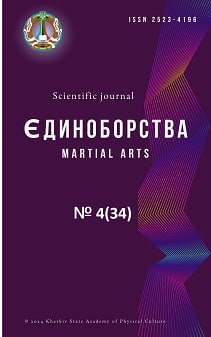Analysis of the competitive activity of young athletes at the 38th children's tournament «Wanpaku Sumo»
DOI:
https://doi.org/10.15391/ed.2024-4.04Keywords:
children's sport, sumo, martial arts, children's sumo, competitive activity, technical and tactical actions, kimariteAbstract
Purpose: to analyze the competitive activity of young athletes at the 38th «Wanpaku Sumo» Children's Tournament. Material and methods. The following methods were used in the study: analysis of scientific and methodological information and Internet sources; generalization of best practices; analysis of protocols and video recordings of matches. A total of 293 fights were analyzed (92 fights among fourth graders, 94 among fifth graders, 107 among sixth graders). For the analysis, a specialized computer program «Martial Arts Video Analysis» was used. Results: the analysis of competitive activity allowed us to identify the groups of techniques most often used by athletes during competitions. The most frequently used techniques of the group kihon waza (57,65 %). Athletes of all age groups actively used the basic technique (4th grade – 57,60%, 5th grade – 57,44 %, 6th grade – 57,94 %). The most common techniques in all age categories were yorikiri and oshidashi. Actions that occurred during the competition and belong to the hiwaza group and are not kimarite indicate that young athletes do not yet have perfect control over their bodies and can lose balance even without the intervention of an opponent. The analysis of technical actions allowed us to observe the progress of technique by grade. Thus, in the fifth grade, more complex techniques (harimanage and chongake) appear. This indicates that children are gradually mastering more complex techniques that require better coordination and tactical thinking. In the upper grades, the use of complex techniques such as tsukiotoshi and sotogake is observed. This indicates that participants are becoming physically stronger and more coordinated, which indicates a gradual mastery of more complex techniques. Conclusions. The analysis of the competition during the 38th «Wampaku Sumo» Tournament revealed some characteristic features. First, the competitions were highly intense. The yorikiri technique is the most effective, so it is very popular among young athletes. Although yorikiri dominates, the presence of other techniques such as koshinage and makiotoshi shows that participants have a diverse arsenal of techniques. In high school, participants begin to demonstrate better physical fitness, which helps them to use more complex techniques and endure bouts longer. Psychological pressure also plays a role, as participants are forced to make quick decisions and choose techniques that are most effective under pressure.References
Байрамов, Р. (2021). Організаційно-управлінські основи розвитку неолімпійського спорту в Харківській області (на прикладі сумо) (дис. на здобуття наукового ступеня доктора філософії). Харків, Україна.
Голоха, В. Л. (2023). Характеристика технічних дій в боротьбі сумо. Проблеми і перспективи розвитку спортивних ігор і єдиноборств у вищих навчальних закладах, 20-23.
Голоха, В. Л., & Тропін, Ю. М. (2023). Порівняльний аналіз технііко-тактичного арсеналу чоловіків і жінок в сумо. Єдиноборства, 2 (28), 36-49. https://10.15391/ed.2023-2.04.
Ложечка, М. В. (2013). Історичні аспекти становлення та розвитку сумо в сучасній Україні. Економічний універсам: метафізика пізнання, 21-22.
Новини Дніпра – [Електронний ресурс]. – Режим доступу: https://www.gorod.dp.ua/news/228972 (дата звернення: 23.09.2024).
Офіційний сайт Дніпровської обласної ради – [Електронний ресурс]. – Режим доступу: https://u.to/U_HuIA (дата звернення: 23.09.2024).
Офіційний сайт «Посольство України в Японії» – [Електронний ресурс]. – Режим доступу: https://japan.mfa.gov.ua/news/taiho (дата звернення: 23.09.2024).
Офіційний сайт професійного сумо – [Електронний ресурс]. – Режим доступу: https://www.sumo.or.jp/En/ (дата звернення: 4.10.2024).
Офіційний сайт «Українська федерація сумо» [Електронний ресурс]. – Режим доступу: http://sumo-ua.com (дата звернення: 4.10.2024)
Романенко, В., Голоха, В., Алексєєв, А., & Коваленко, Ю. (2020). Методика оцінки змагальної діяльності одноборців з використанням комп’ютерних технологій. Слобожанський науково-спортивний вісник, 6(80), 65–72. https://10.15391/snsv.2021-5.003
Суспільне Рівне – [Електронний ресурс]. – Режим доступу: https://suspilne.media/rivne/558611-11-ricnij-rivnanin-sered-krasih-sumoistiv-aponii-istoria-makara-upatkina/ (дата звернення: 23.09.2024).
Тропін, Ю. М., Голоха, В. Л., & Ахметов, Ф. Ш., (2023) Техніко-тактичний арсенал професійних борців сумо. Єдиноборства, 1(27), 14-21. https://10.15391/ed.2023-1.07
Тропін, Ю. М., Голоха, В. Л., Перевозник В. І. (2023). Техніко-тактичний арсенал борчинь сумо на 14-му чемпіонаті світу. Єдиноборства, 4(30), 89-103. https://10.15391/ed.2023-4.09
Bairamov, R., & Bondar, A. (2020). Ways to attract the population to sumo. Scienses of Europe, 54, 3, 59-62.
CYOLY – Style of Sports and Technology – [Електронний ресурс]. – Режим доступу: https://cyclestyle.net/article/2015/07/27/25694.html. (дата звернення: 29.09.2024).
Nippon – [Електронний ресурс]. – Режим доступу: https://www.nippon.com/es/news/l00308/ (дата звернення: 06.09.2024)
ISF – Сайт міжнародної федерації Сумо – [Електронний ресурс]. – Режим доступу: http://www.ifs-sumo.org/index.html (дата звернення: 06.09.2024).
JCI – Junior Chamber International Shijonawate – [Електронний ресурс]. – Режим доступу: http://portfolio.mnwr.me/jc/wanpaku/2024/ (дата звернення: 01.10.2024).
JCI – Junior Chamber International AWAJI – [Електронний ресурс]. – Режим доступу: https://awaji-jc.or.jp/2022a/activities/350-2/ / (дата звернення: 01.10.2024).
あれこれ雑記ブログ – [Електронний ресурс]. – Режим доступу: https://turugiri.com/wanpaku-zumou/ (дата звернення: 01.10.2024).
わんぱく相撲全国大会 – сайт Ванпаку сумо – [Електронний ресурс]. – Режим доступу: https://www.wanpaku.or.jp/wanpaku/ (дата звернення: 03.10.2024).
わんぱく相撲全国大会 – Правила змагань з Вампаку сумо – [Електронний ресурс]. – Режим доступу: https://www.wanpaku.or.jp/tournament/rule.html (дата звернення: 03.10.2024).













